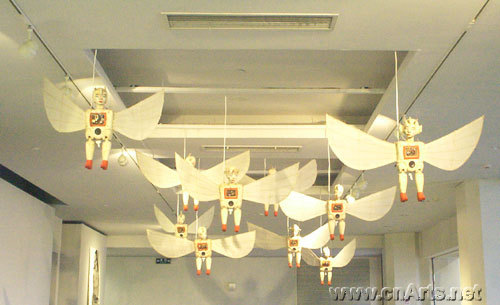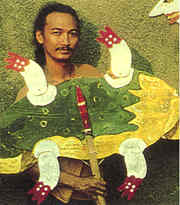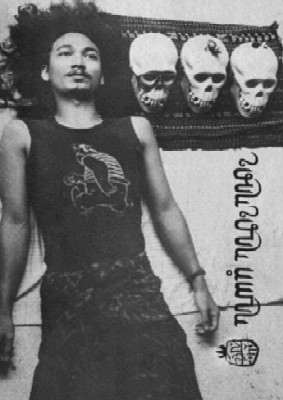Home | Vol 13 Table of Contents | Previous Issues | Contact Us: 07 55278753 / 0405463663 | Email: judybyronbay@yahoo.com
Siapa Heri Dono ? - a beautiful mind!The most commonly-heard comments used to describe Heri Dono on his recent visit to Australia were - 'inspiring!' 'warm and joyful' 'charismatic' - ' a beautiful person!'. Heri Dono is perhaps Indonesia's most travelled visual artist - globetrotting for the last 10 years, respresenting Indonesia at major art events in Europe, Japan, America, Australia - the world, Heri has been enormously successful on every level. Heri has been described as a shaman and his work as comic and grotesque. To experience Heri's art is to enter his world - a dream-like landscape of bizarre, humorous and often cheeky images which also often contain incisive social and political criticism and comment. AIAA members in Brisbane and Byron found Heri generous with his time and were overjoyed to have the chance to see and discuss his work first hand. Heri will return to Brisbane in 11-25 January 2003 to participate in the Childrens' Festival. All we can say is - ' We Love You Heri! Come back soon.' js Louise Carlin from Suara Indonesia, BayFm Radio interviewed Heri Dono at Brisbane Art Gallery. Louise: OK. We're here talking with Heri Dono in Brisbane. Heri is in
Australia at the moment for the Asia Pacific Triennial Exhibition at the
Heri: Salamat dating ke Brisbane Australia… Welcome Louise: Thankyou. Can you tell us a little bit about your works - for the listeners in Byron Bay who haven't seen the exhibition? Heri: Well, people in Byron Bay, I now exhibit three pieces of work that I exhibit in the APT. Actually, I participated in the first APT and also the last APT in 1999. I exhibit again now. I exhibit three works one of the works is called "Flying Angels". Louise: I heard that one of the "Flying Angels" caught on fire…on the opening day. Is that right? Heri: Yes…. So now one of the Angel's name is "Flaming Angels"! (Laughter) Heri: Maybe still adapting with the weather here. Louise: Was that on purpose - the "Angel" being on fire, or was it a spontaneous thing? Heri: I think it was spontaneous because in Indonesia it is 220 voltage
and here it is 240, so maybe it is a little bit too hot especially in
this autumn weather. Another of the works is "Ceremony Of The Soul" and
the third work is "Glass Vehicles". The Flying Angels I made in 1996 after
I returned from England. At that time I made my solo exhibition at the
Museum of Modern Art in Oxford England. I had a problem at the time, the
Indonesian Ambassador in London did not like my work. He sent me some
letters and said if I didn't want to withdraw the catalogue, I can't return
to Indonesia. At th From that time I made the angels as a symbol of freedom. The angel itself is a symbol of inspiration - and that people cannot stop the inspiration. These angels were inspired by the comic strip Flash Gordon - this comic of Flash Gordon existed before Neil Armstrong walked on the moon. This proves that inspiration is always forward in the future, like our life... like hoping...wishing for something in the future. So I made a lot of angels in this exhibition. I exhibit ten angels - and the other work is the Ceremony of the Soul. These are stones from Mount Merapi - from the volcano, and they are carved by gravediggers in the cemetery. Louise: So that's the actual stone that comes from the volcano near Yogyakarta, is that right? Heri: From the North of Yogyakarta. Louise: So these look like half-human half-robot kind of figures in the sand. Heri: Yeah right, and it also has an electric fence in yellow colors. We call it kuningisasi or kuningism - that everything becomes yellow from the Golkar Party - from the government party in the Suharto regime. And the other work is "Glass Vehicles" - this is a container for krupkuk or for crackers. There are some figures inside of the crackers - most of the figures are male in the front and female in the back...that still until now there is domination of the male in many institutions. But it is fortunate now that the president is a woman - Megawati. "The Glass Vehicles" is like a paradox or the situation between the time or the system of glory and also slavery. This Vehicle is like a becak or pedicab or tricyclo. And this is public transportation ridden by a person in the back of the vehicle and for the passengers in the front, but also the glory vehicle from the kingdom with the horses. Its like for a king. Louise: Like a horse carriage? Heri: Yes, that's right.. so we don't have middle class society - only the rich and the poor. Glass vehicles are like going -- to where?..We are not sure… These are like vehicles from another planet. Louise: I noticed that a lot of those figures in the glass vehicles looked like military puppets. Heri: Yes, the male figures use the guns or weapons and they are also like robots in the chest - like a mechanical life. Because everything becomes mechanical after brainwashing by the propaganda or indoctrination. Louise: So your work here has a lot of political and social statements about gender roles and a lot of comments about the government and the Suharto regime. This seems quite prominent in your works. Heri: Yes, I think I cannot run away from the situation because to me art is not only to get the sense of beauty but also to make people conscious or aware about what is going on. In the Suharto regime many projects of the government are " Projects of stupidity" that does not make people more clever but more stupid. So brainwashing is in the schools and in the education and I think this is very tragic for our future. Louise: You were saying to me earlier that the schools won't teach the
children about your artwork. And it's only the students who Heri: Yes, there is the double standard about what education is - because they only look at what theory we have - but they don't look at the phenomena we have. Because the reality is the books maybe printed in 1950s, are very different from our life. Louise: Its very outdated Heri: Yes, its true - Especially in the art sense or art field - Artists work in creativity and every creativity looks at the phenomenon today. Sometimes what they make does not yet exist in theory. Maybe when people make a theory people then have to wait for the next five years to see the phenomenon crystalise what the artist made. Very often I am rejected by any cultural institution because my work is not in the box of the ism or the convention that the art critic or art historian talks about, so my work always didn't have any box. Because I work in performance, in installations, in painting and also in puppets, in sound, in video, in new media - there is not any box to me. Louise: It goes across the board - Heri: Yes - as an outsider everywhere. (laughing) Louise: Or embrace it all ! So Heri, I'd like to ask you - What's your opinion about the opportunities for an Indonesian artist starting off young? Heri: Well for young artists, I think they have to be confident to break out of the old system. They have to be confident to create art work not only from one category or one art discipline like painting, sculpture or design or music, dance or theatre - all of them are only media and everyone can work in different media, even only words on paper can make poem or they can use their body for performance, they can use the new media like vision - everything can become art. They also need to respect what they make - they can look at the phenomenon around their life. I think its not necessary that their technique is very high or not high - its just about how to look at the work context with our life - as a witness or expression about life. Many young artists in Indonesia are also open-minded with any kind of culture they can get. And its good if they don't make any boxes for their work - they make a bridge. We have many good artists in performance, in installation, and in the conventional arts like sculpture and painting. I am very optimistic that many young artists - are working without any support from the senior artists or institutions. I think that sometimes the young artists don't need the galleries and the formal places - I think they have to make another way to express their work. Louise: So how old were you when you decided to be an artist? HEri: When I was 17 years old in 1977, I exhibited my work in the Primary School. At that time I was in High School, but near my home, I have a primary school and I use the gallery space for my exhibition and I make a kind of installation - at that time there was no word for installation. I made experimental art. Also after I started at art school in 1980 I exhibited my work at the beach called 'Experimental Arts' with about 300 artists and we use the nature, we want to understand nature. We worked on the beach, we made a tent, we slept there, we made music, we made a party. We understand about the reef, about the ocean...about the wind. We also worked with some composers and musicians and some traditional puppeteers as well - people who don't know about art...anyone can participate in arts! I don't care if poeple say my work is bad or good, because this is not about bad or good... its about how to develop our perception in arts- to question again - what is art? The good thing is -any medium can make any possibility - to become an artist is the same as to be freedom, because an artist is never retired, never discharged, an artist has a feeling of 100% freedom. Louise: You can't get sacked... like fired Heri: No you can't get fired, because an artist itself is an institution. Louise: Its not going to go bangkrupt. Heri: No- as long as the spirit is enriched. So they can live with their spirit. Baik, teman2 di Byron Bay, saya - Heri Dono senang sekali kalau teman2 bisa datang ke pameran saya- pameran group di Asia Pacific Triennial di Qld Art Gallery dan bulan January juga saya akan datang ke Brisbane dari tgl 11 sampai tgl 25 Januari acara Children's Festival. Email Heri Dono: hmmdonut@mailcity.com |
 Queensland Art Gallery. Welcome Heri Dono.
Queensland Art Gallery. Welcome Heri Dono.
 at
time in every corner in every place in Indonesia were stickers and banners
about the 50 Years Anniversary of Independence, but at that time I didn't
feel independent and also I can't go home. I felt so scared at that time,
and also I couldn't stay in Europe because the European economic community
rejected all of the immigrant people to stay in Europe. Finally, I made
a letter to the Indonesian Ambassador to withdraw my catalogue and then
I went home.
at
time in every corner in every place in Indonesia were stickers and banners
about the 50 Years Anniversary of Independence, but at that time I didn't
feel independent and also I can't go home. I felt so scared at that time,
and also I couldn't stay in Europe because the European economic community
rejected all of the immigrant people to stay in Europe. Finally, I made
a letter to the Indonesian Ambassador to withdraw my catalogue and then
I went home.
 travel internationally that get to know your name and are educated about
the work you do - as you are quite a celebrated artist in the world. But
you were saying in Indonesia in the schools they don't embrace you as
an artist. Your artwork is suppressed.
travel internationally that get to know your name and are educated about
the work you do - as you are quite a celebrated artist in the world. But
you were saying in Indonesia in the schools they don't embrace you as
an artist. Your artwork is suppressed.